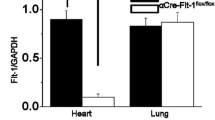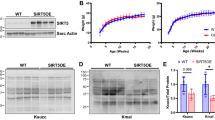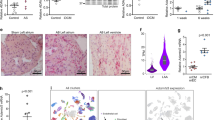Abstract
Fibroblast growth factor 2 (FGF2), produced as high (Hi-) and low (Lo-) molecular weight isoforms, is implicated in cardiac response to injury. The role of endogenous FGF2 isoforms during chronic stress is not well defined. We investigated the effects of endogenous Hi-FGF2 in a mouse model of simulated pressure-overload stress achieved by transverse aortic constriction (TAC) surgery. Hi-FGF2 knockout mice, expressing only Lo-FGF2, FGF2(Lo), and wild-type mice, FGF2(WT), expressing both Hi-FGF2 and Lo-FGF2, were used. By echocardiography, a decline in systolic function was observed in FGF2(WT) but not FGF2(Lo) mice compared to corresponding sham-operated animals at 4–8 weeks post-TAC surgery. TAC surgery increased markers of myocardial stress/damage including B-type natriuretic peptide (BNP) and the pro-cell death protein BCL2/adenovirus E1B 19 kDa protein-interacting protein-3 (Bnip3) in FGF2(WT) but not FGF2(Lo) mice. In FGF2(Lo) mice, cardiac levels of activated FGF receptor 1 (FGFR1), and downstream signals, including phosphorylated mTOR and p70S6 kinase, were elevated post-TAC. Finally, NR1D1 (nuclear receptor subfamily 1 group D member 1), implicated in cardioprotection from pressure-overload stress, was downregulated or upregulated in the presence or absence, respectively, of Hi-FGF2 expression, post-TAC surgery. In wild-type cardiomyocyte cultures, endothelin-1 (added to simulate pressure-overload signals) caused NR1D1 downregulation and BNP upregulation, similar to the effect of TAC surgery on the FGF2(WT) mice. The NR1D1 agonist SR9009 prevented BNP upregulation, simulating post-TAC findings in FGF2(Lo) mice. We propose that elimination of Hi-FGF2 is cardioprotective during pressure-overload by increasing FGFR1-associated signaling and NR1D1 expression.







Similar content being viewed by others

References
Azhar M, Yin M, Zhou M, Li H, Mustafa M, Nusayr E, Keenan JB, Chen H, Pawlosky S, Gard C, Grisham C, Sanford LP, Doetschman T (2009) Gene targeted ablation of high molecular weight fibroblast growth factor-2. Developmental dynamics : an official publication of the American Association of Anatomists 238:351–357
Brewer JR, Mazot P, Soriano P (2016) Genetic insights into the mechanisms of Fgf signaling. Genes Dev 30:751–771
Conrad N, Judge A, Tran J, Mohseni H, Hedgecott D, Crespillo AP, Allison M, Hemingway H, Cleland JG, McMurray JJV, Rahimi K (2018) Temporal trends and patterns in heart failure incidence: a population-based study of 4 million individuals. Lancet (London, England) 391:572–580
Cross MJ, Lu L, Magnusson P, Nyqvist D, Holmqvist K, Welsh M, Claesson-Welsh L (2002) The Shb adaptor protein binds to tyrosine 766 in the FGFR-1 and regulates the Ras/MEK/MAPK pathway via FRS2 phosphorylation in endothelial cells. Mol Biol Cell 13:2881–2893
deAlmeida AC, van Oort RJ, Wehrens XH (2010) Transverse aortic constriction in mice. Journal of visualized experiments : JoVE
Doble BW, Dang X, Ping P, Fandrich RR, Nickel BE, Jin Y, Cattini PA, Kardami E (2004) Phosphorylation of serine 262 in the gap junction protein connexin-43 regulates DNA synthesis in cell-cell contact forming cardiomyocytes. J Cell Sci 117:507–514
Doble BW, Ping P, Kardami E (2000) The epsilon subtype of protein kinase C is required for cardiomyocyte connexin-43 phosphorylation. Circ Res 86:293–301
Florkiewicz RZ, Sommer A (1989) Human basic fibroblast growth factor gene encodes four polypeptides: three initiate translation from non-AUG codons. Proc Natl Acad Sci U S A 86:3978–3981
Frohlich ED, Susic D (2012) Pressure overload. Heart Fail Clin 8:21–32
Ghosh R, Gilda JE, Gomes AV (2014) The necessity of and strategies for improving confidence in the accuracy of western blots. Expert Rev Proteomics 11:549–560
Hirst CJ, Herlyn M, Cattini PA, Kardami E (2003) High levels of CUG-initiated FGF-2 expression cause chromatin compaction, decreased cardiomyocyte mitosis, and cell death. Mol Cell Biochem 246:111–116
Jessup M, Brozena S (2003) Heart failure. N Engl J Med 348:2007–2018
Jhanwar-Uniyal M, Wainwright JV, Mohan AL, Tobias ME, Murali R, Gandhi CD, Schmidt MH (2019) Diverse signaling mechanisms of mTOR complexes: mTORC1 and mTORC2 in forming a formidable relationship. Adv Biol Regul 72:51–62
Jiang ZS, Jeyaraman M, Wen GB, Fandrich RR, Dixon IM, Cattini PA, Kardami E (2007) High- but not low-molecular weight FGF-2 causes cardiac hypertrophy in vivo; possible involvement of cardiotrophin-1. J Mol Cell Cardiol 42:222–233
Jiang ZS, Padua RR, Ju H, Doble BW, Jin Y, Hao J, Cattini PA, Dixon IM, Kardami E (2002) Acute protection of ischemic heart by FGF-2: involvement of FGF-2 receptors and protein kinase C. Am J Physiol Heart Circ Physiol 282:H1071-1080
Jimenez SK, Jassal DS, Kardami E, Cattini PA (2011) A single bout of exercise promotes sustained left ventricular function improvement after isoproterenol-induced injury in mice. J Physiol Sci : JPS 61:331–336
Kardami E, Detillieux K, Ma X, Jiang Z, Santiago JJ, Jimenez SK, Cattini PA (2007) Fibroblast growth factor-2 and cardioprotection. Heart Fail Rev 12:267–277
Khanam SS, Son JW, Lee JW, Youn YJ, Yoon J, Lee SH, Kim JY, Ahn SG, Ahn MS, Yoo BS (2017) Prognostic value of short-term follow-up BNP in hospitalized patients with heart failure. BMC Cardiovasc Disord 17:215
Kole D, Grella A, Dolivo D, Shumaker L, Hermans W, Dominko T (2017) High molecular weight FGF2 isoforms demonstrate canonical receptor-mediated activity and support human embryonic stem cell self-renewal. Stem Cell Res 21:106–116
Koleini N, Kardami E (2017) Autophagy and mitophagy in the context of doxorubicin-induced cardiotoxicity. Oncotarget 8:46663–46680
Koleini N, Nickel BE, Nagalingam RS, Landry NM, Fandrich RR, Dixon IM, Czubryt M, Cattini PA, Kardami E (2019a) Abstract 838: high molecular weight FGF2 contributes to pressure overload induced systolic dysfunction by a mechanism associated with modulation of the NR1D1 orphan nuclear receptor expression. Circ Res 125:A838–A838
Koleini N, Nickel BE, Wang J, Roveimiab Z, Fandrich RR, Kirshenbaum LA, Cattini PA, Kardami E (2017) Fibroblast growth factor-2-mediated protection of cardiomyocytes from the toxic effects of doxorubicin requires the mTOR/Nrf-2/HO-1 pathway. Oncotarget 8:87415–87430
Koleini N, Santiago JJ, Nickel BE, Sequiera GL, Wang J, Fandrich RR, Jassal DS, Dhingra S, Kirshenbaum LA, Cattini PA, Kardami E (2019b) Elimination or neutralization of endogenous high-molecular-weight FGF2 mitigates doxorubicin-induced cardiotoxicity. Am J Physiol Heart Circ Physiol 316:H279-h288
Lau AF, Hatch-Pigott V, Crow DS (1991) Evidence that heart connexin43 is a phosphoprotein. J Mol Cell Cardiol 23:659–663
Leong DP, McMurray JJV, Joseph PG, Yusuf S (2019) From ACE Inhibitors/ARBs to ARNIs in coronary artery disease and heart failure (Part 2/5). J Am Coll Cardiol 74:683–698
Liao S, Bodmer J, Pietras D, Azhar M, Doetschman T, Schultz Jel J (2009) Biological functions of the low and high molecular weight protein isoforms of fibroblast growth factor-2 in cardiovascular development and disease. Developmental dynamics : an official publication of the American Association of Anatomists 238:249–264
Liao S, Bodmer JR, Azhar M, Newman G, Coffin JD, Doetschman T, Schultz Jel J (2010) The influence of FGF2 high molecular weight (HMW) isoforms in the development of cardiac ischemia-reperfusion injury. J Mol Cell Cardiol 48:1245–1254
Liao S, Porter D, Scott A, Newman G, Doetschman T, Schultz Jel J (2007) The cardioprotective effect of the low molecular weight isoform of fibroblast growth factor-2: the role of JNK signaling. J Mol Cell Cardiol 42:106–120
Liu GY, Sabatini DM (2020) mTOR at the nexus of nutrition, growth, ageing and disease. Nat Rev Mol Cell Biol 21:183–203
Liu L, Pasumarthi KB, Padua RR, Massaeli H, Fandrich RR, Pierce GN, Cattini PA, Kardami E (1995) Adult cardiomyocytes express functional high-affinity receptors for basic fibroblast growth factor. Am J Physiol 268:H1927-1938
Lyon RC, Zanella F, Omens JH, Sheikh F (2015) Mechanotransduction in cardiac hypertrophy and failure. Circ Res 116:1462–1476
Ma X, Dang X, Claus P, Hirst C, Fandrich RR, Jin Y, Grothe C, Kirshenbaum LA, Cattini PA, Kardami E (2007) Chromatin compaction and cell death by high molecular weight FGF-2 depend on its nuclear localization, intracrine ERK activation, and engagement of mitochondria. J Cell Physiol 213:690–698
Messerli FH, Rimoldi SF, Bangalore S (2017) The transition from hypertension to heart failure: contemporary update. JACC Heart Fail 5:543–551
Nusayr E, Sadideen DT, Doetschman T (2013) FGF2 modulates cardiac remodeling in an isoform- and sex-specific manner. Physiol Rep 1:
Ornitz DM, Itoh N (2015) The fibroblast growth factor signaling pathway. Wiley Interdiscip Rev Dev Biol 4:215–266
Pourcet B, Zecchin M, Ferri L, Beauchamp J, Sitaula S, Billon C, Delhaye S, Vanhoutte J, Mayeuf-Louchart A, Thorel Q, Haas JT, Eeckhoute J, Dombrowicz D, Duhem C, Boulinguiez A, Lancel S, Sebti Y, Burris TP, Staels B, Duez HM (2018) Nuclear receptor subfamily 1 group D member 1 regulates circadian activity of NLRP3 inflammasome to reduce the severity of fulminant hepatitis in mice. Gastroenterology 154:1449-1464.e1420
Qu J, Volpicelli FM, Garcia LI, Sandeep N, Zhang J, Marquez-Rosado L, Lampe PD, Fishman GI (2009) Gap junction remodeling and spironolactone-dependent reverse remodeling in the hypertrophied heart. Circ Res 104:365–371
Reitz CJ, Alibhai FJ, Khatua TN, Rasouli M, Bridle BW, Burris TP, Martino TA (2019) SR9009 administered for one day after myocardial ischemia-reperfusion prevents heart failure in mice by targeting the cardiac inflammasome. Commun Biol 2:353
Santiago JJ, Ma X, McNaughton LJ, Nickel BE, Bestvater BP, Yu L, Fandrich RR, Netticadan T, Kardami E (2011) Preferential accumulation and export of high molecular weight FGF-2 by rat cardiac non-myocytes. Cardiovasc Res 89:139–147
Santiago JJ, McNaughton LJ, Koleini N, Ma X, Bestvater B, Nickel BE, Fandrich RR, Wigle JT, Freed DH, Arora RC, Kardami E (2014) High molecular weight fibroblast growth factor-2 in the human heart is a potential target for prevention of cardiac remodeling. PLoS ONE 9:e97281
Schipke J, Brandenberger C, Rajces A, Manninger M, Alogna A, Post H (1985) Mühlfeld C (2017) Assessment of cardiac fibrosis: a morphometric method comparison for collagen quantification. J Appl Physiol 122:1019–1030
Schirone L, Forte M, Palmerio S, Yee D, Nocella C, Angelini F, Pagano F, Schiavon S, Bordin A, Carrizzo A, Vecchione C, Valenti V, Chimenti I, De Falco E, Sciarretta S, Frati G (2017) A review of the molecular mechanisms underlying the development and progression of cardiac remodeling. Oxid Med Cell Longev 2017:3920195
Shan H, Wei J, Zhang M, Lin L, Yan R, Zhang R, Zhu YH (2015) Suppression of PKCε-mediated mitochondrial connexin 43 phosphorylation at serine 368 is involved in myocardial mitochondrial dysfunction in a rat model of dilated cardiomyopathy. Mol Med Rep 11:4720–4726
Sheikh F, Fandrich RR, Kardami E, Cattini PA (1999) Overexpression of long or short FGFR-1 results in FGF-2-mediated proliferation in neonatal cardiac myocyte cultures. Cardiovasc Res 42:696–705
Shende P, Xu L, Morandi C, Pentassuglia L, Heim P, Lebboukh S, Berthonneche C, Pedrazzini T, Kaufmann BA, Hall MN, Rüegg MA, Brink M (2016) Cardiac mTOR complex 2 preserves ventricular function in pressure-overload hypertrophy. Cardiovasc Res 109:103–114
Srisakuldee W, Jeyaraman MM, Nickel BE, Tanguy S, Jiang ZS, Kardami E (2009) Phosphorylation of connexin-43 at serine 262 promotes a cardiac injury-resistant state. Cardiovasc Res 83:672–681
Srisakuldee W, Makazan Z, Nickel BE, Zhang F, Thliveris JA, Pasumarthi KB, Kardami E (2014) The FGF-2-triggered protection of cardiac subsarcolemmal mitochondria from calcium overload is mitochondrial connexin 43-dependent. Cardiovasc Res 103:72–80
Stujanna EN, Murakoshi N, Tajiri K, Xu D, Kimura T, Qin R, Feng D, Yonebayashi S, Ogura Y, Yamagami F, Sato A, Nogami A, Aonuma K (2017) Rev-erb agonist improves adverse cardiac remodeling and survival in myocardial infarction through an anti-inflammatory mechanism. PLoS ONE 12:e0189330
Tanai E, Frantz S (2015) Pathophysiology of heart failure. Comprehensive. Physiology 6:187–214
Teiger E, Than VD, Richard L, Wisnewsky C, Tea BS, Gaboury L, Tremblay J, Schwartz K, Hamet P (1996) Apoptosis in pressure overload-induced heart hypertrophy in the rat. J Clin Invest 97:2891–2897
Vaissiere A, Berger S, Harrus D, Dacquet C, Le Maire A, Boutin JA, Ferry G, Royer CA (2015) Molecular mechanisms of transcriptional control by Rev-erbalpha: an energetic foundation for reconciling structure and binding with biological function. Protein science : a publication of the Protein Society 24:1129–1146
Volterrani M, Iellamo F, Senni M, Piepoli MF (2017) Therapeutic options of angiotensin receptor neprilysin inhibitors (ARNis) in chronic heart failure with reduced ejection fraction: beyond RAAS and sympathetic nervous system inhibition. Int J Cardiol 226:132–135
Walker JR, Sharma A, Lytwyn M, Bohonis S, Thliveris J, Singal PK, Jassal DS (2011) The cardioprotective role of probucol against anthracycline and trastuzumab-mediated cardiotoxicity. Journal of the American Society of Echocardiography : official publication of the American Society of Echocardiography 24:699–705
Wang F, Iskra B, Kleinerman E, Alvarez-Florez C, Andrews T, Shaw A, Chandra J, Schadler K, Aune GJ (2018) Aerobic exercise during early murine doxorubicin exposure mitigates cardiac toxicity. J Pediatr Hematol Oncol 40:208–215
Woldt E, Sebti Y, Solt LA, Duhem C, Lancel S, Eeckhoute J, Hesselink MK, Paquet C, Delhaye S, Shin Y, Kamenecka TM, Schaart G, Lefebvre P, Neviere R, Burris TP, Schrauwen P, Staels B, Duez H (2013) Rev-erb-alpha modulates skeletal muscle oxidative capacity by regulating mitochondrial biogenesis and autophagy. Nat Med 19:1039–1046
Zhang L, Parry GC, Levin EG (2013) Inhibition of tumor cell migration by LD22-4, an N-terminal fragment of 24-kDa FGF2, is mediated by Neuropilin 1. Cancer Res 73:3316–3325
Zhang L, Zhang R, Tien CL, Chan RE, Sugi K, Fu C, Griffin AC, Shen Y, Burris TP, Liao X, Jain MK (2017) REV-ERBalpha ameliorates heart failure through transcription repression. JCI Insight 2:
Zhao XS, Pan W, Bekeredjian R, Shohet RV (2006) Endogenous endothelin-1 is required for cardiomyocyte survival in vivo. Circulation 114:830–837
Funding
Research was funded by an operating grant by the Canadian Institutes for Health Research (CIHR, #74733) to Elissavet Kardami (Prinicipall Investigator; with co-applicants Peter Cattini and Davinder Jassal), and by the Molson Women’s Heart Health Foundation (Elissavet Kardami). Other funding: MPC was supported by a CIHR Open Operating Grant (MOP136862). NK and RSN were the recipients of a Bank of Montreal studentship award via the St. Boniface Hospital Albrechtsen Research Centre; NK was also supported via University of Manitoba funding to PAC, who holds the H.G. Friesen Chair in Metabolic and Endocrine Disorders.
Author information
Authors and Affiliations
Corresponding authors
Ethics declarations
Ethics approval and consent to participate
All applicable international, national, and/or institutional guidelines for the care and use of animals were followed.
Conflict of interest
The authors declare no competing interests.
Additional information
Publisher's Note
Springer Nature remains neutral with regard to jurisdictional claims in published maps and institutional affiliations.
Supplementary Information
Below is the link to the electronic supplementary material.
441_2021_3465_MOESM1_ESM.tiff
Supplementary file1 Figure S1. Elimination of Hi-FGF2 prevents pressure overload-induced increase in left ventricular end diastolic diameter (LVESD), but has not effect on left ventricular end diastolic diameter (LVEDD)The graphs show echocardiographic measurements of LVESD, and LVEDD, at 8 weeks post-sham (green) or –TAC surgery (magenta) surgery, in FGF2(WT) and FGF2(Lo) mice, as indicated. Brackets point to significant difference between mice subjected to TAC versus sham surgery (p < 0.05) by 2-way-ANOVA LSD post-hoc. Sample sizes are n = 9–17. (TIFF 8671 KB)
441_2021_3465_MOESM2_ESM.tiff
Supplementary file2 Figure S2. Elimination of endogenous Hi-FGF2 prevents TAC surgery induced increases in cardiomyocyte surface area. Typical picrosirius-red stained images (rendered in black and white) of cardiac transverse sections obtained at 8 weeks post- sham or TAC surgery from FGF2(WT) and FGF2(Lo) groups, as indicated (TIFF 8671 KB)
441_2021_3465_MOESM3_ESM.tiff
Supplementary file3 Figure S3. Typical images of cross-sections from hearts of FGF2(WT) and FGF2(Lo) mice subjected to sham or TAC surgery as indicated. Sections were stained by immunofluorescence for collagen IV, to outline pericellular areas. Typical whole hearts images, placed on an actual ruler (marking 1 mm-distanced segments) are included in each panel (TIFF 8671 KB)
441_2021_3465_MOESM4_ESM.tiff
Supplementary file4 Figure S4. FGFR1 accumulation remains unchanged by FGF2 isoform composition or TAC surgery. Panel a. FGF1 mRNA levels determined by qPCR and normalized to the value for WT-FGF2(Sham) arbitrarily defined as 1. Differences between groups were not statistically significant (P > 0.05), as compared by 2-way ANOVA. Panel b. Relative levels of immunoreactive, ~ 100 kDa, FGFR1, adjusted for variation in protein loading (Ponceau), did not show statistically significant differences between groups. Panel c shows the immunoblot for FGFR1, and the corresponding Ponceau-stained membrane, as indicated. Values from the lane marked with a red asterisk were excluded, due to abnormal appearance of the total protein profile indicative of degradation (TIFF 8671 KB)
Rights and permissions
About this article
Cite this article
Koleini, N., Nickel, B.E., Nagalingam, R.S. et al. Elimination of endogenous high molecular weight FGF2 prevents pressure-overload-induced systolic dysfunction, linked to increased FGFR1 activity and NR1D1 expression. Cell Tissue Res 385, 753–768 (2021). https://doi.org/10.1007/s00441-021-03465-0
Received:
Accepted:
Published:
Issue Date:
DOI: https://doi.org/10.1007/s00441-021-03465-0



